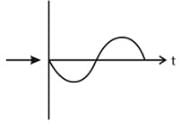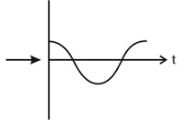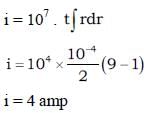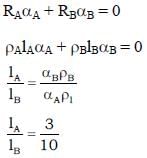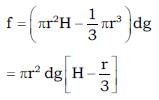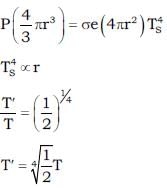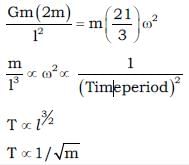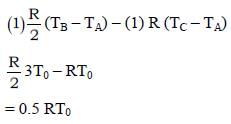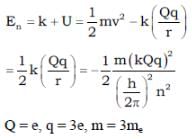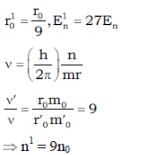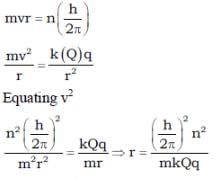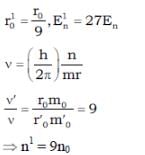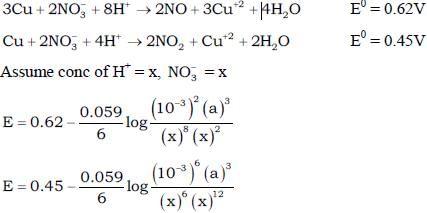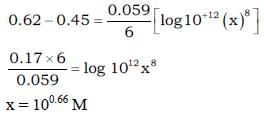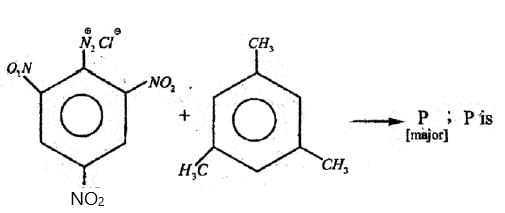JEE Main Practice Test- 10 - JEE MCQ
30 Questions MCQ Test - JEE Main Practice Test- 10
A solid ball rolls down a parabolic path ABC from a height h as shown in figure. Portion AB of the path is rough while BC is smooth. How high will the ball climb in BC ?


A heat engine has an efficiency η. Temperatures of source and sink are each decreased by 100 K. Then, the efficiency of the engine.
A particle is moving in a uniform circular motion on a horizontal surface. Particle position and velocity at time t = 0 are shown in the figure in the coordinate system. Which of the indicated variable on the vertical axis is incorrectly matched by the graph shown alongside for particle's motion-
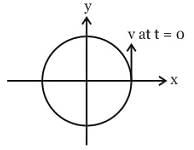

In Coolidge tube experiment, if applied voltage is increased to three times, the short wavelength limit of continuous X - ray spectrum shifts by 20 pm. What is the initial voltage applied to the tube ?
A washer is made of metal having resistivity 10–7 Ωm. The washer has inner radius 1 cm, outer radius 3 cm and thickness 1 mm. A magnetic field, oriented normal to the plane of the washer, has the time dependent magnitude B = (2t) tesla/sec. Find the current (in ampere) around the washer
Ends of two wires A and B having resistivity  and
and  of same cross section area joined in series together to from a single wire. If the resistance of the joined wire does not change with temperature, then find the ratio of their lengths
of same cross section area joined in series together to from a single wire. If the resistance of the joined wire does not change with temperature, then find the ratio of their lengths  given that temperature coefficient of resistivity of wire A and B is
given that temperature coefficient of resistivity of wire A and B is
αA= 4 ×10–5/ °C and αB = –6 × 10–6/°C. Assume that mechanical dimensions do not change with temperature
A cone of radius = height = r is under a liquid of density d. Its base is parallel to the free surface of the liquid at a depth H from it as shown in the figure. What is the net force due to liquid on its curved surface? (neglect atmospheric pressure)

A spherical black body has a radius R and steady surface temperature T, heat sources ensure the heat evolution at a constant rate and distributed uniformly over its volume. What would be the new steady surface temperature of the object if the radius is decreased by half? Assume surrounding to be at absolute zero and heat evolution rate through unit volume remain same.
The smallest length scale known in physics is the Planck length. It is an important ingredient in some current cosmological theories. Which of the following expressions could represent this Planck length? (Symbols has usual meaning)
In the figure shown two motors P1 & P2 fixed on a plank which is hanging with light string passing over fixed Pulley P. If the motors start winding the thread with angular velocity ω1 & ω2 then velocity of plank V is (here R1 & R2 are the radii of motor rotor respectively) [Given: ω1 = 2 rad/s, R1 = 2m, ω2 = 2 rad/s, R2 = 3m]
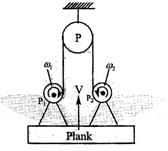
Five identical balls each of mass m and radius r are strung like beads at random and at rest along a smooth, rigid horizontal thin road of length L, mounted between immovable supports. Assume 10r < L and that the collision between balls or between balls and supports are elastic. If one ball is struck horizontally so as to acquire a speed v, the average force felt by the support is

A double star is a system of two stars rotating about their centre of mass only under their mutual gravitational attraction. Let the stars have masses m and 2m and let their separation be l. Their time period of rotation about their centre of mass will be proportional to
If white light is used in a Young’s double – slit experiment. Point C represents centre of a screen
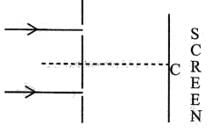
Consider a thermodynamic cycle in a PV diagram shown in the figure performed by one mole of a monoatomic gas. The temperature at A is T0 and volume at A and B are related as VB = VC = 2VA. Choose the correct option(s) form the following
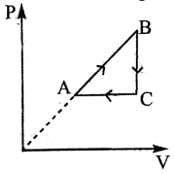
If the plank’s constant would be double the present value, in the Bohr’s model for hydrogen atom
In 1906, Robert Millikan devised an experiment that allowed him to determine the charge of an electron. A schematic of Millikan’s set – up is shown below:
Two metal plates are connected by a series of batteries to form a capacitor. There is an electric field between the plates. The metal plates are inside an insulated cylindrical container.
Oil drops are introduced into the container through a small hole in the top. The oil drops acquire a negative charge as they pass through the nozzle of the oil can. Some of the drops fall through a hole in the upper plate. By adjusting the voltage between the plates, certain drops can be suspended between them. The relationship between the electric field between the plates and the voltage across the plates is ∆V = EL
Where E is the electric field and L is the plate separation.
Millikan chose oil because of its relatively low vapour pressure and high charge holding ability. (To answer the following question assume oil drops as to be non-conducting tiny spheres)
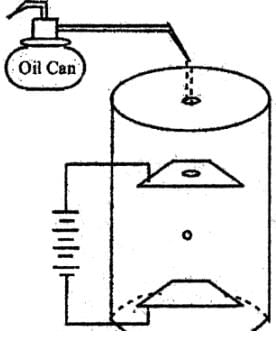
In order for an oil drop of mass m, radius r and volume charge density ρ, to be suspended between the plates, the magnitude and direction of the electric field must be:
In 1906, Robert Millikan devised an experiment that allowed him to determine the charge of an electron. A schematic of Millikan’s set – up is shown below:
Two metal plates are connected by a series of batteries to form a capacitor. There is an electric field between the plates. The metal plates are inside an insulated cylindrical container.
Oil drops are introduced into the container through a small hole in the top. The oil drops acquire a negative charge as they pass through the nozzle of the oil can. Some of the drops fall through a hole in the upper plate. By adjusting the voltage between the plates, certain drops can be suspended between them. The relationship between the electric field between the plates and the voltage across the plates is ∆V = EL
Where E is the electric field and L is the plate separation.
Millikan chose oil because of its relatively low vapour pressure and high charge holding ability. (To answer the following question assume oil drops as to be non-conducting tiny spheres)
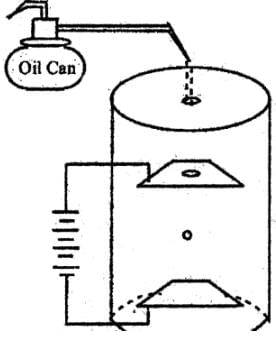
Suppose the original oil droplet were replaced with a positively charged one that had twice the charge and three times the mass of the original droplet, how would the magnitude of the electric field have to be changed in order for the drop to remain suspended?
In a hypothetical atom, a negatively charged particle having a charge of magnitude 3e and mass 3m revolves around a proton. Here, e is the electronic charge and m is the electronic mass. Mass of proton may be assumed to be much larger than that of the negatively charged particle, thus the proton is at rest. This “atom” obeys Bohr’s postulate of quantization of angular momentum, that is  It is given that for the first Bohr orbit of hydrogen atom: radius of orbit is r0 speed of electron is V0, and total energy is –E0. Now answer the following questions.
It is given that for the first Bohr orbit of hydrogen atom: radius of orbit is r0 speed of electron is V0, and total energy is –E0. Now answer the following questions.
Speed of the revolving particle is, in the first Bohr orbit.
In a hypothetical atom, a negatively charged particle having a charge of magnitude 3e and mass 3m revolves around a proton. Here, e is the electronic charge and m is the electronic mass. Mass of proton may be assumed to be much larger than that of the negatively charged particle, thus the proton is at rest. This “atom” obeys Bohr’s postulate of quantization of angular momentum, that is  It is given that for the first Bohr orbit of hydrogen atom: radius of orbit is r0 speed of electron is V0, and total energy is –E0. Now answer the following questions.
It is given that for the first Bohr orbit of hydrogen atom: radius of orbit is r0 speed of electron is V0, and total energy is –E0. Now answer the following questions.
Radius of hypothetical atom is
In a hypothetical atom, a negatively charged particle having a charge of magnitude 3e and mass 3m revolves around a proton. Here, e is the electronic charge and m is the electronic mass. Mass of proton may be assumed to be much larger than that of the negatively charged particle, thus the proton is at rest. This “atom” obeys Bohr’s postulate of quantization of angular momentum, that is  It is given that for the first Bohr orbit of hydrogen atom: radius of orbit is r0 speed of electron is V0, and total energy is –E0. Now answer the following questions.
It is given that for the first Bohr orbit of hydrogen atom: radius of orbit is r0 speed of electron is V0, and total energy is –E0. Now answer the following questions.
The momentum of an emitted photon when it makes a transition from the second excited state to ground state, is
The given figure shows a plot of the time dependent force x F acting on a particle in motion along the x-axis. What is the total impulse (in kg-m/s) delivered by this force to the particle from time t = 0 to t = 2 second?
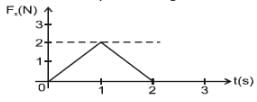
In the figure shown a small block B of mass m is released from the top of a smooth movable wedge A of the same mass m. The height of wedge A shown in figure is h = 16 cm. B ascends another movable smooth wedge C of the same mass. Neglecting friction anywhere find the maximum height (in cm) attained by block B on wedge C.

Mass 2m is kept on a smooth circular track (R = 9 meters) of mass m which is kept on a smooth horizontal surface. The circular track is given a horizontal velocity  towards left and released. Find the maximum height reached by 2m in meters.
towards left and released. Find the maximum height reached by 2m in meters.

Two blocks of masses m1 and m2 are connected by spring of constant K such that m2/m1=9. The spring is initially compressed and the system is released from rest at t = 0 second. The work done by spring on the blocks m1 and m2 be ω1 and ω2 respectively by time t. The speeds of both the blocks at time ‘t’ are non-zero. Then find the value of ω1/ω2.

Two simple pendulums of length 5 m and 20 m respectively are given small linear displacement in one direction at the same time. They will again be in the phase when the pendulum of shorter length has completed .... oscillations.
Copper reduces  into NO and NO2 depending upon concentration of HNO3 in solution. Assuming [Cu2+] = 0.1M, and PNO = PNO2 = 10–3 bar. At which concentration of HNO3, thermodynamic tendency for reduction of
into NO and NO2 depending upon concentration of HNO3 in solution. Assuming [Cu2+] = 0.1M, and PNO = PNO2 = 10–3 bar. At which concentration of HNO3, thermodynamic tendency for reduction of  into NO and NO2 by copper is same?
into NO and NO2 by copper is same?

A radioactive material (t1/2 = 30 days) gets spilled over the floor of a room. If initial activity is ten times the permissible value, after how many days will it be safe to enter the room
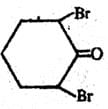 A mixture of all possible stereoisomers from the above structure is subjected to fractional distillation, which of the following statements is correct
A mixture of all possible stereoisomers from the above structure is subjected to fractional distillation, which of the following statements is correct
Which of the following about SF4, SOF4 and COF2 molecules is correct?




